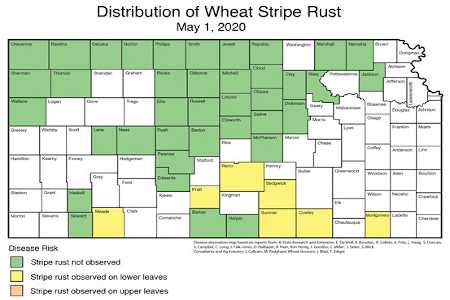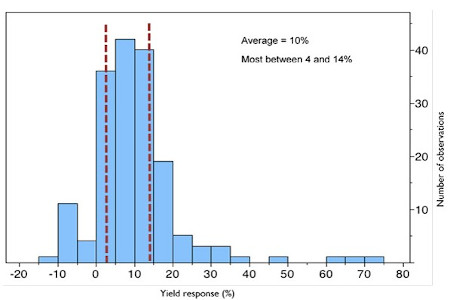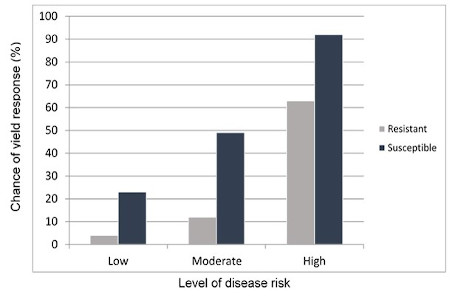By Erick DeWolf
The leaf diseases leaf rust, stripe rust, tan spot, Septoria tritici blotch, and powdery mildew are the most common cause of disease-related yield loss. Often, leaf diseases are managed by a combination of genetic resistance and crop rotation; however, foliar fungicides may be needed when these practices fail to keep diseases at low levels.
This year, low levels of stripe rust were detected in several counties in South Central Kansas during the last week of April (Figure 1). So far the disease is restricted to the middle canopy and still at a very low incidence. Many growers may be evaluating the potential need for fungicides over the next 7-14 days.

Figure 1. Distribution of stripe rust in Kansas as of May 1, 2020. Map is based on observations of K-State Research and Extension, crop consultants, and wheat producers in the state. Map created by Erick DeWolf, K-State Research and Extension.
This article features some selected key points from a KSRE publication that answers common questions about the role of fungicides in wheat disease management and helps evaluate the need for a fungicide by analyzing information available at the time of application. The entire publication, MF3057 “Evaluating the Need for Wheat Foliar Fungicides”, can be viewed at https://bookstore.ksre.ksu.edu/pubs/MF3057.pdf
When should a fungicide be applied relative to crop growth?
Fungicides can best protect these critical growth stages from disease when applied between full emergence of the flag leaf and anthesis (flowering). Diseases that damage plants at these early stages often reduce the grain yield significantly. Fungicide applications made before flag leaf emergence generally result in less disease control on the upper leaves during grain development and smaller yield responses. Always check and follow product label recommendations to ensure full compliance with growth-stage limitations and pre-harvest intervals.
How long will the fungicide provide disease control?
The residual life of the fungicide application is influenced by the product used, rate of application, and disease targeted for control. In general, products belonging to the triazole and strobilurin classes of fungicide will provide 14 to 21 days of disease control. Small differences in residual life among products typically do not result in large differences in grain yield.
In general, the fungicides stay near the site of application or move toward the leaf tip. The fungicides only protect leaves, stems, and heads present at the time of application.
Are there important differences in how well various fungicide products work?
Nearly all fungicide products labeled and widely marketed for use on wheat in Kansas contain active ingredients belonging to triazole (DMI), carboxamides (SDHI) and strobilurin (QoI) classes of fungicides or mixtures of these classes. Both fungicide classes are effective at controlling common leaf diseases in Kansas. Products containing only the triazole class of fungicides are the best option in areas prone to Fusarium head blight (head scab). There are a few options containing triazole + carboxamides that would also be a good option of head blight control. More information about product options and efficacy against diseases can be found in the K-State Research and Extension publication EP130 Foliar Fungicide Efficacy Ratings for Wheat Disease Management.
What is the typical yield response of wheat to foliar fungicides?
Researchers with K-State Research and Extension have been evaluating the potential role of fungicides in leaf disease management for many years. In most situations, these experiments were specifically designed to evaluate the benefits of fungicides when susceptible varieties are grown in environments extremely favorable for disease development. A summary of decades of experiments indicates that a single fungicide application between flag leaf emergence and anthesis often results in a yield increase between 4 and 14 percent, with an average yield increase of 10 percent (Figure 2). These figures can be combined with yield potential of a wheat crop to estimate the potential yield response in bushels per acre.

Figure 2. Typical yield response of wheat to foliar fungicides. This plot shows the frequency of different yield responses in 20+ years of research trials in Kansas. Graph from Erick DeWolf, K-State Research and Extension.
What information maximizes the potential benefits of the fungicide application?
Because the yield response to fungicides is variable, it is often helpful to consider different approaches that can maximize the potential benefits of the fungicide application. While it may not be possible to predict the yield response to a fungicide application perfectly, it is possible to use the information at the time of application to improve the chances of obtaining an above-average yield response.
Set priorities based on a variety’s balance of genetic resistance and susceptibility to disease.
Information about the disease resistance of a wheat variety is often available well before fungicide decisions need to be made. In fact, for most varieties this information is available before purchase of the seed. Information about the disease reaction of wheat varieties to leaf diseases in Kansas can be found in the Wheat Variety Disease and Insect Ratings, MF991, available from K-State Research and Extension. A variety’s reaction to disease often changes over time and it is important to use the most recent information when evaluating a variety’s disease resistance. These variety ratings are updated annually to ensure the most current information is available.
Refine the decision based on the risk of severe disease.
In Kansas, the two primary indicators of disease risk are regional outbreaks of the rust diseases and the presence of disease within a field before the heading stages of growth. Using this information, the risk of disease can be classified as low, moderate, or high (Table 2). Research indicates that fungicides are most likely to result in an above-average yield response in production scenarios that combine varieties that are susceptible to multiple leaf diseases with high levels of disease risk (Figure 3). The likelihood of an above-average yield response is reduced at the moderate and low levels of disease risk.

Figure 3. Chance of an above-average yield response to a foliar fungicide based on a variety's reaction to multiple leaf diseases and low, moderate, and high levels of disease risk.
Integrate yield potential and weather into the decision.
Yield potential of a wheat crop and weather information available at the time of application also can influence the final decision to apply a fungicide. Fields with a good yield potential, at least 40 bushels per acre, at the time of application and fields intended for seed production should be a high priority.
These priorities are further reinforced when weather forecasts indicate conditions are likely to remain favorable for wheat growth and disease development. It is wise to more carefully analyze the use of fungicides (and avoid additional input costs) when drought, freeze injury, viral diseases, or other production problems make a crop’s yield potential uncertain. Freezing temperatures during the week of April 12 have many growers questioning yield potential this year. Where possible, it is wise to take some time to see how the crop recovers before adding more input costs to a crop with a narrow profit margin.
Source : ksu.edu